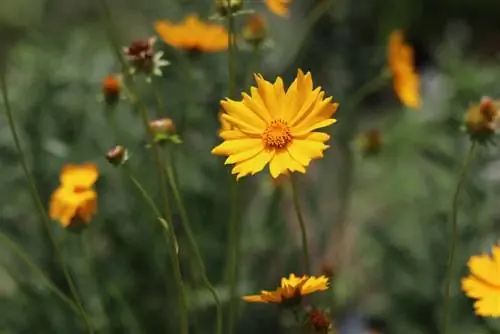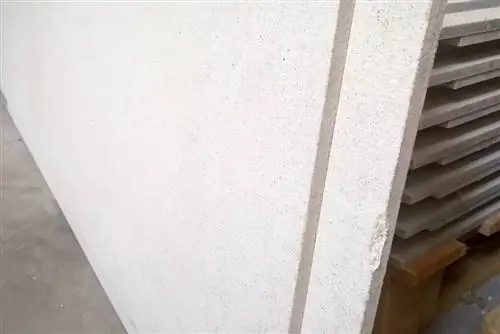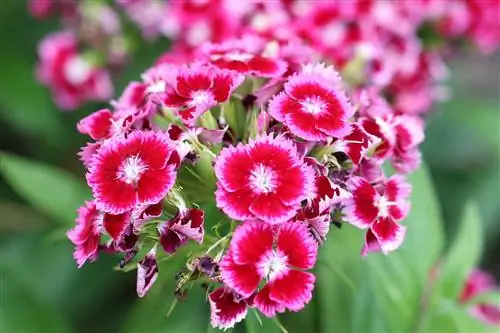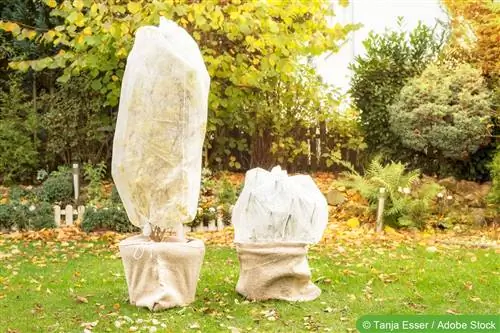- Author admin [email protected].
- Public 2023-12-17 03:39.
- Last modified 2025-01-24 12:45.
Their bright yellow flowers shine in competition with the sun all summer long. Girls' eyes also know how to hold their own against any competition in the bed, because their robust, undemanding nature is legendary. Immigrated from the New World, the magnificent coreopsis have taken the hearts of hobby gardeners by storm as tireless flowering perennials. The bedding and cut flowers owe their popular status not least to their typical undemanding nature. The following tips on care and wintering guarantee a marginal amount of work for the summer flower magic.
Profile
- Plant family Asteraceae
- Genus: Girl's Eyes (Coreopsis)
- Native to North America
- Perennial, herbaceous flowering perennials
- Growth height from 10-80 rarely up to 200 centimeters
- Yellow star flowers with dark eye
- Flowering period from June to October
- Dark green, lanceolate or pinnate leaves
- Deciduous and hardy
Location, soil and substrate
The girl's eye can be found everywhere in the creatively designed garden. It creates colorful accents in the perennial bed. As a bed border, it surpasses any evergreen alternative with beauty and grace. The splendor of the yellow flowers is unsurpassed against the dark backdrop along the edge of a tree. In the wild variety of the natural cottage garden, coreopsis are an indispensable component. With its graceful attributes, the summer flower also impresses in large pots or flower boxes on the balcony and terrace. This wide range of possible uses is based on the following site conditions:
- Full sunny locations with as many hours of sunshine as possible
- Nutritious, humus-rich soil
- Fresh-moist to sandy-loamy and well-drained
Cultivated in a planter, commercially available potting soil is suitable as a substrate. Ideally, permeability is optimized by adding sand, perlite or expanded clay.
Tip:
Drainage made of crushed pottery shards over the water drain in the bottom of the bucket reliably prevents harmful waterlogging. A water- and air-permeable fleece spread over it prevents the substrate from clogging the drainage.
Watering and fertilizing
If Coreopsis finds adequate site conditions, half of the way to successful care is already achieved. In the water supply, your intervention is only necessary when the natural rainfall is insufficient. The leaner the soil, the more beneficial additional nutrients are for flowering and growth.
- Watering girls' eyes in summer drought
- Water directly to the roots early in the morning or in the evening
- A portion of garden compost with horn shavings every now and then works wonders
Caring for Coreopsis in pots and balcony boxes requires a little more attention. Water the flowers regularly, allowing the substrate surface to dry in between. Any coaster should be emptied after 20 minutes at the latest to prevent waterlogging from developing. Liquid compost or guano fertilizer sticks can be used as organic fertilizer. If you run a worm composting facility, the girls' eyes will be happy to receive a dose of rich worm tea every 14 days. Alternatively, specialist retailers have a we alth of suitable liquid fertilizers for flowering plants.
Tip:
Never apply liquid fertilizer to dried soil as this will cause burns to the roots.
Cutting
A regular cut of wilted and withered flower stems promotes vitality and always attracts new flowers. If the seeds are used for later propagation by sowing, pruning is not necessary in late summer. The fruit heads can ripen and are collected. At the same time, the birds in the garden are happy because the seeds serve as a valuable source of food for them.
Wintering
Since not all types and varieties of Coreopsis are completely hardy, protection from frost and cold is recommended. Only in mild wine-growing regions can the following measures be dispensed with:
- Cut the perennial close to the ground before the first frost
- Alternatively, leave the withered plant parts and only remove them next spring
- Hill up the root area with soil, leaves, bark mulch or pine needles
- Place planters on Styrofoam or wood in front of the south wall of the house
- Wrap with bubble wrap, garden fleece or jute
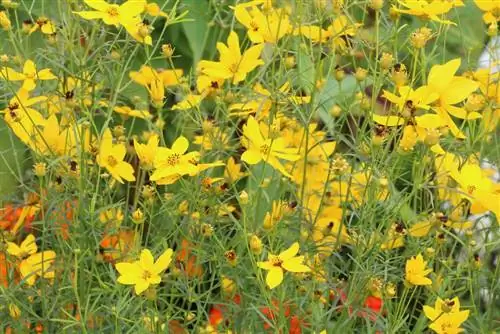
Inexperienced hobby gardeners are always amazed that the plants in the garden are more at risk from drought stress in winter than in summer. This is particularly true in the context of cold frost. This unfavorable constellation arises when the snow cover fails despite extremely low temperatures. In frozen ground, the roots cannot access water, while no moisture is supplied from above. Therefore, during the cold season, girls' eyes are watered a little both in the bed and in the bucket on frost-free days.
Propagate
There can hardly be enough examples of this summer flower wonder in the garden. Good to know how easy it is to propagate. There are various approaches to choose from, all of which work excellently:
Division
The most uncomplicated method for growing numerous new girls' eyes, even with an inexperienced hand. The best time for division is early spring when the ground has completely thawed. The root ball is loosened all around with the digging fork and dug out. Use a sharp knife or spade to divide the plant so that each segment has at least 2-3 buds. Once planted in the new location, care for each section immediately like an adult girl's eye.
Cuttings
During the months of June and July, the perfect time window opens for propagation through cuttings. Here's how to do it:
- Select he althy shoots with multiple leaves
- Cut just below a knot to a length of 10-15 centimeters
- Defoliate the lower half of the cutting
- Fill cultivation pots with nutrient-poor substrate
- Plant 2-3 cuttings each and water them
In a partially shaded location, the cuttings root quickly while they must be kept constantly moist. If a fresh shoot appears, an independent root system has developed and the young girls' eyes are planted out.
Sowing
The seeds you harvest yourself or buy are sown indoors from March onwards. Fill a seed tray with peat sand, perlite or coconut fibres, scatter the seeds and sift them over with sand or substrate to the thickness of the seeds. The sensitive seeds are preferably moistened with water from a spray bottle. Germination takes 4-6 weeks in a partially shaded window seat at 15 to 18 degrees Celsius. You can influence the process positively by placing a plastic film over the cultivation containers. Ideally, an indoor greenhouse is available. As soon as 2 to 3 real leaves form above the cotyledons, the seedlings are transplanted into individual pots. To prevent the young plants from dying, a cooler location of 12-13 degrees is recommended. Any cover falls away, at the latest when the leaves permanently touch it. From mid-May onwards, the coreopsis have grown to such an extent that they can be relocated to the bed or the planter.
Conclusion
The girl's eye combines bright yellow flowers with robust undemanding. It is therefore considered the ideal flowering perennial for a summer garden that does not require extensive care. As long as their location is sunny enough, Coreopsis delight the eye with their cheerful appearance in the bed, on the edge of the tree or on the balcony. In addition to watering in dry conditions and a little fertilizer every now and then, the pivotal point in care is regular cleaning and cutting of withered plant parts. For a he althy winter, all you need to do is pile up soil and leaves and a drink of water on frost-free days.

